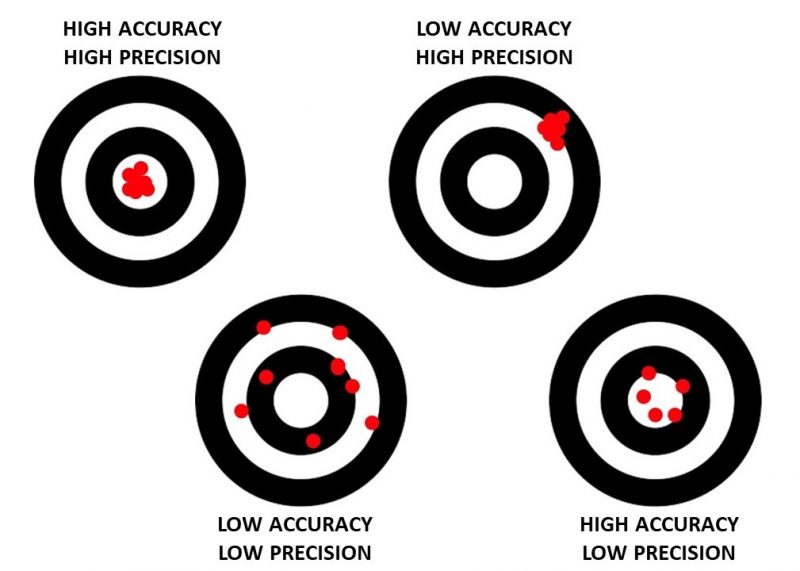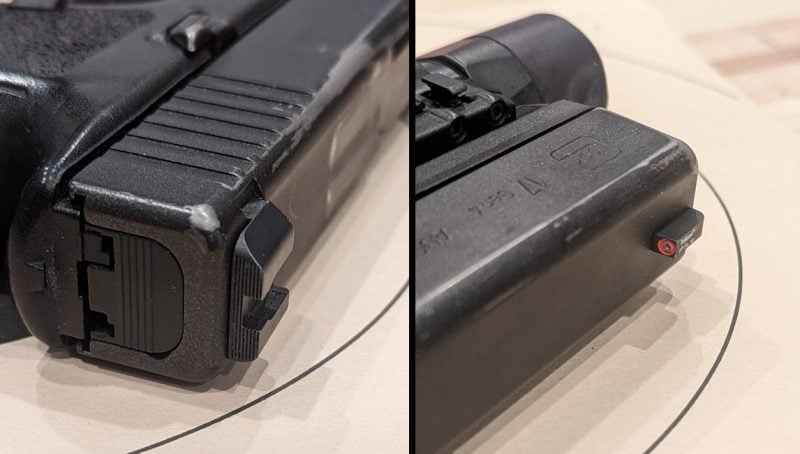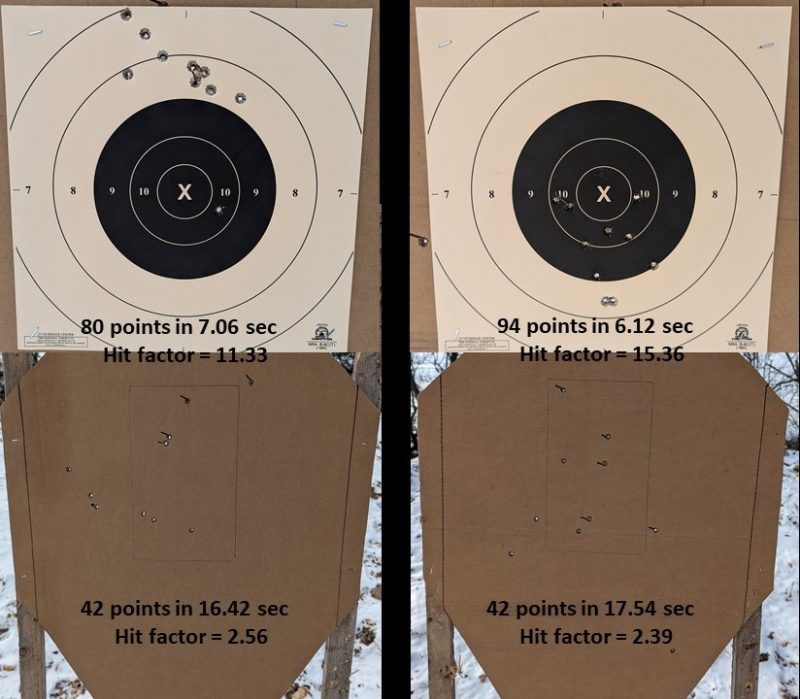Handgun sights are obviously important. After all, if you can’t see the sights (or the target), accurate shot placement is unlikely. With the proliferation of pistol red dot optics, it seems the answer to accurate shot placement for many is in the handgun sights or optic. However, as we’ll discuss later, handgun sights aren’t the be-all, end-all of handgun accuracy and precision. Before delving into the importance of handgun sights, let’s discuss the role and importance of shooting accuracy and precision.
Accuracy vs Precision with Handgun Sights
In a previous life, I pursued a PhD in toxic metal geochemistry. Life happened and, after recovering from a major car accident, my path routed away from academia. Nevertheless, my experience in scientific rigor and terminology bled into my approach towards law enforcement and firearms. Science emphasized the importance of accuracy and precision. Coincidentally, those two concepts are exceptionally important in proper firearms marksmanship. While accuracy and precision are occasionally interchanged, they’re two distinct concepts.

Accuracy and precision describe observational error. For example, accuracy is a measurement of how close you are to the actual value. With shooting, accuracy is hitting the bullseye. Precision is how close measurements are to each other. If your groups are tight, you have high precision. If the group is off target but tight, it’s precise but lacks accuracy. While interesting, how do accuracy and precision relate to handgun sights?
Precision’s Role
Handgun sights have little to no importance with precision. Before I’m burned at the stake, let me expand. First, how do you shoot precisely? Well, three things affect you hitting the same spot with each shot: the ammunition, firearm, and user. Handgun engagements are commonly well inside 25 yards. Most handguns and ammunition, independent of human influence, shoot groups in the range of a few inches or less at 25 yards. For mere mortals, we’re largely incapable of replicating these groups offhand and under stress. Accordingly, precision is largely — and quite literally — in our hands. Handgun precision occurs through the consistency of fundamentals. Trigger control, grip, stance, sight picture, and sight alignment factor into precision. Sight type doesn’t play as important of a role in precision as we may think.
Accuracy’s Role
Accuracy is exceptionally important. A one-inch handgun group at 25 yards doesn’t matter if it’s three feet off the intended target. Handgun sights are critical for accuracy. Sights must shoot true OR the shooter must know the appropriate holdover. For years, I employed a set of Hackathorn Ameriglo sights on my duty Glock. I love their style: serrated blackout rear with bright orange Tritium front. However, they notoriously shot a little high at distances beyond 10 yards. Since they’re not elevation adjustable, I adjusted my sight position. This is a harsh reality for fixed-sight handguns. If the sights are windage or elevation adjustable, especially with optics, they must be dialed in for the handgun and shooter.

Types of Handgun Sights
What type of handgun sights are available to maximize accuracy? A detailed answer to this question would require a list so exhaustive that my time and your attention are better spent elsewhere. Nonetheless, I’ll summarize handgun sights simply as: fixed (non-adjustable), target (adjustable for windage and elevation), combat (normally fixed, but windage adjustable with a punch or tool), and optics. These sights each serve a purpose. However, some sights are better for one application than another depending on the user and circumstances.

The undeniable popularity of pistol red dot optics suggests they’re beneficial. After spending the last year or so practicing with one, I tend to agree. A pistol optic eliminates the guesswork of sight alignment and sight picture. See dot, put dot on target, and press trigger. If the precision (e.g. the fundamentals) is correct, the bullet should go where the dot is placed. Unfortunately, the red dot is frequently, but not always, a mask for inadequate training and practice with iron sights. While I may be slaying a sacred cow with such a statement, I make the aforementioned claim with some anecdotal evidence.
Some years ago, Trijicon released their HD sights. These sights featured a wide “U”-notch rear with bright orange or green front sight. I was approached by several HD owners who believed the wide rear sight left too much room for error and caused poor accuracy. After several range sessions and demonstrations, their diagnosis was in error. The issue wasn’t the wide rear notch, but their consistency in placing the front sight directly in the middle of the rear notch. Understandably, the average shooter may not observe this inconsistency with irons. However, it’s immediately recognizable with an optic. Simply, red dot users receive immediate feedback if their sight alignment sucks. They can honestly — and inexcusably — diagnose the error in their precision.
Do Handgun Sights Matter?
All this discussion brings us to the ultimate question, how important are handgun sights? I ultimately decided upon an unconventional test for the answer; I shot a several courses of fire with and without handgun sights. While I’m not the first to do this, I had never personally done so. After all, it’s theory until you experience it yourself; then it’s reality.
Testing the Theory
For this proof of concept, I employed my well-worn Glock 17 9mm. This pistol is topped with Hackathorn Ameriglo sights and has around 25,000 rounds through it. Undeniably, this pistol is a personal favorite and saved my life on one occasion. I’d say that’s a good reason to hold it in high esteem.
For testing, I kept things simple. The first course of fire was shot with the sights on the gun. Starting from a Safariland ALS holster, I fired five strings of one shot onto an IDPA target from 7 yards. The total hits, misses, and times were calculated to develop a hit factor (points divided by time). “A” zone hits were five points while hits on paper but outside the “A” zone were three points. This same course of fire was then repeated at 20 yards. The final drill was the venerable “10-10-10” drill (10 shots in 10 seconds from 10 yards beginning at low ready on a B-8 target).

After completing the drills with irons, I went to the trusty bench vise and removed the pistol’s sights. I then conducted the same course of fire without any kind of sights. This minimized my shooting “accuracy” while isolating the precision aspect. Arguably, if my fundamentals sucked, so would the groups. While not an excuse for poor performance, I chose less-than-ideal environmental conditions. Temperatures during testing were a balmy 8 degrees Fahrenheit with a -6 wind chill. I occasionally paused between courses of fire to regain feeling in my hands.
Results
Since I’ve never conducted this test before, I didn’t know what to expect. Surprisingly, the hit factor increased during the 7- and 20-yard drills without sights. While I wanted to conduct further testing, I’m no fan of the cold and grew weary of not feeling appendages. As such, these results lack some scientific rigor. Sighted testing was first and served as a bit of a “warm-up” for the unsighted shooting.

The hit factor increase at 7- and 20-yard ranges was nothing overtly significant. There was little difference in time on target as well. However, there was just enough difference to tip the score. It’s interesting shooting a firearm without sights. Since there is no sight alignment or picture, familiarity and comfort determine shot placement. After accurately performing the same action thousand of times with dry and live-fire, I developed “muscle memory” with confirmed repeatable results. Furthermore, since I was performing fewer tasks to shoot (no sights to focus on, align, etc), I experienced less task “saturation” during each string of fire. I was far more attentive to grip, stance, breathing, and (most importantly) trigger control.
The final drill, the 10-10-10, illuminated the distinct separation between accuracy and precision. With sights, I ran the drill in 6.12 seconds with a final score of 94 (15.36 hit factor). Without sights, my score dropped to 80 in 7.06 seconds (11.33 hit factor). The most intriguing observation came from the group sizes. I achieved an approximately 4-inch group with sights while the group without sights had 9 out of 10 shots in a 4.25-inch spread (the one flyer, ironically in the bullseye, was the byproduct of slapping the trigger). The groups were eerily close in size but differed in location.
Integrating Accuracy and Precision
To become better shooters, we have to check our ego at the door. There’s a distinct difference between an explanation and an excuse for poor performance. Explanations seek to correct the behavior while excuses attempt to brush it off. With handgun sights, it isn’t the gun or the sights normally driving inadequate performance. Rather, it’s a lack of training on the system and poor fundamentals. The decision to explain or excuse poor performance lies in the user’s approach to the problem.
I’m not advocating against red dot optics or upgrading pistol sights. By all means, do so if it improves your ability to acquire the sights and get accurate shots on target. However, don’t fall into the classic shooter’s excuse of “there’s something wrong with my sights”. Analyze whether the issue is your precision (fundamentals) before leaping to accuracy (the gun or sights). Handgun sights matter but repeatable, consistent, and proper fundamentals make the greatest difference in your performance.


